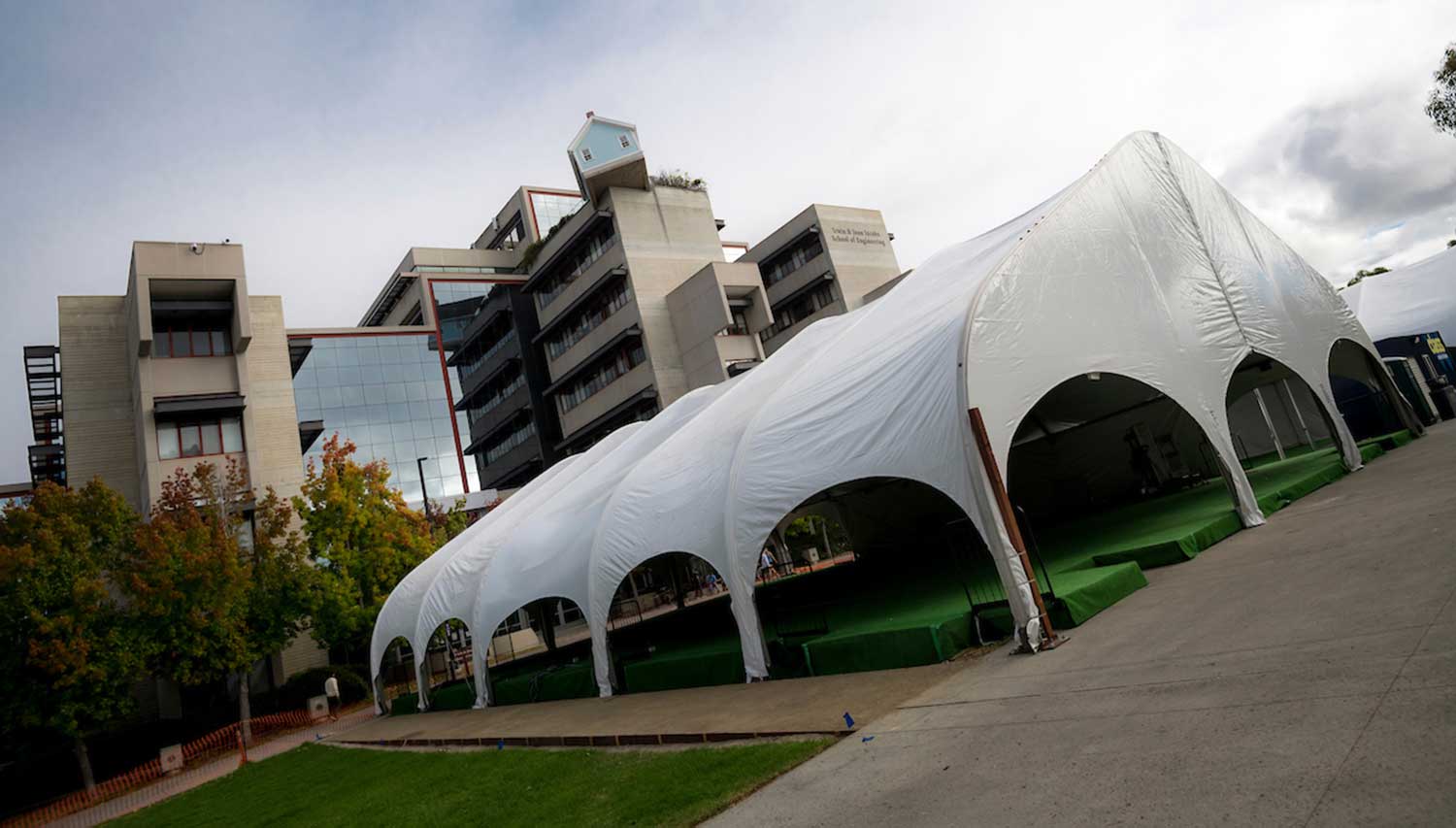By:
- Erika Johnson
Published Date
By:
- Erika Johnson
Share This:

Q&A: Teaching Tents Take Shape
UC San Diego’s plan to return to in-person teaching, learning and research is continually evolving, informed by the university’s Return to Learn program. New ideas pop up every day, and many have taken off—like the use of massive tents to enable students to learn outdoors.
How did these tents take shape, what technology is available and which classes will be taught outdoors? To answer these and other questions, we spoke with Carlos Jensen, associate vice chancellor of Education Innovation at UC San Diego.
Q. How can faculty members request one of the teaching tents for their in-person course?
A. Based on guidance from the state and the San Diego County Public Health Department, in order to protect the health and safety of our campus community, instructors who have included an in-person course element must now transition to remote or outdoor teaching no later than Nov. 23. All lecture, discussion, seminar, lab, or studio classes may be taught either remotely or outdoors; an FAQ webpage has been developed for questions about the transition to remote and outdoor teaching.
To explore the possibility of teaching outdoors this Fall, faculty may contact AVC-EI Carlos Jensen about scheduling and logistics. In addition, faculty may request a teaching tent for the Winter Quarter—in the same way they would request any other indoor space—through their department scheduler.
Q. What types of spaces are offered?
A. There are four large tents available—with a maximum capacity of 50 people—for lectures and other teaching needs in accordance with public health guidelines. In addition, the large spaces are open to graduate students to defend their thesis to faculty and family members.
Several smaller support tents have also been set up—with a maximum capacity of 35 people—as a place for students to drop-in and study as well as meet with a TA or tutor. Currently, use is on a first come, first served basis, but we may transition to a reservation system if the demand grows.
Q. Where are they located, and why were these sites chosen?
A. There are two large classrooms and two study areas in Revelle College and two large classrooms with three study areas in Warren Mall. There were many factors considered when choosing these locations. First, we needed a large, flat area that was on a main thoroughfare. There also needed to be a close power supply as well as a nearby building with ADA accessible restrooms.
In terms of weather, these structures were placed in areas that have good air flow—but not too much wind. We are fortunate to have campus experts who have compiled years of wind speed measurements and air flow models that helped us determine the best location for outdoor learning.
Q. How does learning and studying outdoors contribute to greater safety?
A. According to Dr. Robert Schooley, professor of Infectious Disease at UC San Diego School of Medicine, COVID-19 infections occur through the transmission of virus-containing droplets and aerosols exhaled from infected individuals during breathing, speaking, coughing and sneezing. The risk of becoming infected with the novel coronavirus is lower outside because the concentration of the virus is diluted. Breezes and winds can help transport infectious droplets and aerosols away instead of lingering in the air. They can be further dispersed by attaching to other particles such as dust and pollution. Additionally, the virus can be inactivated by ultraviolet radiation in sunlight and it is likely sensitive to ambient temperature and relative humidity. Our intention is for these classroom tents to offer greater ventilation—and when combined with masking and physical distancing—help keep our students and faculty safe.
Q. What technology is available in the teaching tents?
A. The 80- by 60-foot outdoor classrooms are ADA compliant with the capacity to seat up to 50 students physically distanced. Each space features a comprehensive A/V setup, including boosted Wi-Fi, Zoom and podcasting equipment, weatherproof pendant speakers, microphones and LCD display screens located throughout the space as well as traditional whiteboards. Speakers have been configured near the top of the tent to provide direct sound to the audience, rather than towards neighboring buildings. They also have the same enhanced cleaning services as traditional campus classrooms.
Though these classrooms are outdoors, they meet every quality measure that we have for an indoor classroom. The tents are constructed to withstand rain and wind, with raised floors and foldable walls in case of inclement weather. They are meant to be first class learning environments.
Q. Are there certain courses that will have priority reservations?
A. We are giving priority to programs and classes that don’t have adequate indoor solutions. We are in conversations with the Department of Music and the Department of Theatre and Dance about how to accommodate their teaching and performance needs. For instance, they often do not need tables, but they may need different surfaces for dance instruction.
A great benefit of these outdoors spaces is that they can become a fantastic opportunity for students to be exposed to different courses and majors. Students may walk by a teaching tent and overhear an interesting discussion, or see a professor playing the drums, and that will motivate them to explore new areas of study. I think it’s going to change our culture of learning.
Have more questions? We invite the campus community to submit your inquiries online. A new Q&A with a Return to Learn expert will be published each Thursday in This Week @ UC San Diego for the next several weeks.
Share This:
You May Also Like
Stay in the Know
Keep up with all the latest from UC San Diego. Subscribe to the newsletter today.



